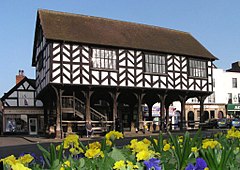Ledbury
| Ledbury | |
|---|---|
 The Market House, Ledbury |
|
| Ledbury shown within Herefordshire | |
| Population | 9,290 (2011) |
| OS grid reference | SO710373 |
| Unitary authority |
|
| Shire county | |
| Region | |
| Country | England |
| Sovereign state | United Kingdom |
| Post town | LEDBURY |
| Postcode district | HR8 |
| Dialling code | 01531 |
| Police | West Mercia |
| Fire | Hereford and Worcester |
| Ambulance | West Midlands |
| EU Parliament | West Midlands |
| UK Parliament | |
Ledbury is a Herefordshire market town, lying east of Hereford, and west of the Malvern Hills.
It has a significant number of timber-framed structures, in particular along Church Lane and High Street. One of the most outstanding is the Market House, built in 1617, located in the town centre. Other notable buildings include the parish church of St. Michael and All Angels, the Painted Room(containing sixteenth-century frescoes), the Old Grammar School, the Barrett-Browning memorial clock tower (designed by Brightwen Binyon and opened in 1896 to house the library until 2015), nearby Eastnor Castle and the St. Katherine's Hospital site.
Founded c.1231, this is a rare surviving example of a hospital complex, with hall, chapel, a Master's House (fully restored and opened in March 2015 to house the Library), almshouses and a timber-framed barn.
Ledbury is a borough whose origins date to around 690 AD. In the Domesday Book it was recorded as Liedeberge. It may take its name from the River Leadon on which it stands. Old English burg (fortified or defended site) has been added to the river name.
As a town it was created on a bishop's manor, probably, like Leominster, Bromyard and Ross-on-Wye, in the episcopate of Bishop Richard de Capella (1121-1127). It returned members to Parliament in the reign of Edward I. The Feathers Hotel was a famous 16th century drovers' inn. It was not until the reign of Queen Elizabeth I that his 'poor town' became prosperous thanks mainly to three families of clothier merchants, Skynner, Skyppe, and Elton. No less than four battles were fought during the English civil wars, during which it was a bastion of royalism. Thereafter the arrival of the Martin and Biddulph during the age of aristocracy and into the Victorian signalled a financial sea-change for the town from these banker landowners; Biddulph was later ennobled.
...
Wikipedia

